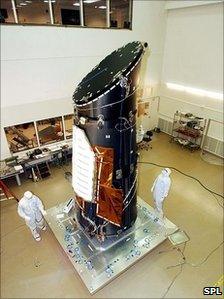Earth-sized worlds much more common than giant planets
- Published

The Kepler mission should find tens or even hundreds of Earth-sized planets
Nearly one in four stars like the Sun could have Earth-sized planets, according to a new estimate published in the journal Science.
that on average small, so-called rocky planets are much more common in orbit close to their star than giant planets planets similar in size to Jupiter.
This estimate is based on observations from nearby stars taken by the the twin 10-metre Keck telescopes in Hawaii. These show that 22 of the stars had detectable planets.
The researchers estimated that about 1.6% of the Sun-like stars in their sample had Jupiter-size planets and 12% had so-called "super-Earths", which are between three and 10 times the mass of the Earth.
Best guess
The Keck telescopes are not powerful enough to detect planets that are any smaller, so the scientists have assumed that this trend toward more smaller planets continues and estimated that 23 of the stars had Earth-sized planets.
Dr Andrew Howard, from the University of California at Berkeley, admits that the estimate is currently impossible to back up using existing data.
However, he says it is the first estimate that has been obtained using observations of relatively small planets.
"This extrapolation is the least certain part of our analysis. The true answer might be one in eight or one in two - but we know that it isn't one in 100," he told ±«Óătv News.
Based on these statistics, Dr Howard says that Nasa's Kepler space telescope - which is to to survey 156,000 stars - will detect between 120 and 260 "plausibly terrestrial worlds".
"If there's life out there, it's most likely that it exists on rocky planets like our own Earth. So if there are more rocky small planets out there, then it seems more likely that there's life out there too," he said.
But according to Dr Robert Massey of the Royal Astronomical Society, most of the worlds they predict exist would be too close to be habitable.
"We probably need to wait a bit longer before we find a significant number of 'Earths' in habitable zones of their parent stars."
- Published9 September 2010
- Published24 August 2010
- Published30 September 2010
- Published26 August 2010